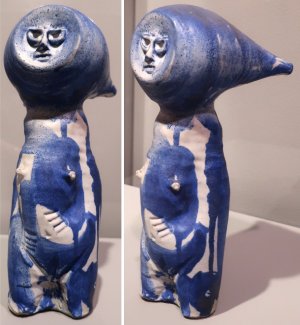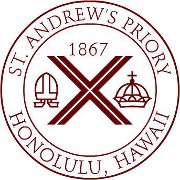
Huna is the word adopted by the New Age author Max Freedom Long (1890–1971) in 1936 to describe his theory of metaphysics. Long cited what he believed to be the spiritual practices of the ancient Hawaiian kahunas (priests) as inspiration; however, contemporary scholars consider the system to be his invention designed through a mixture of a variety of spiritual practices from various cultures, with roots in New Thought and Theosophy, rather than in traditional Hawaiian beliefs.

Kalākaua, was the last king and penultimate monarch of the Kingdom of Hawaiʻi, reigning from February 12, 1874, until his death in 1891. Succeeding Lunalilo, he was elected to the vacant throne of Hawaiʻi against Queen Emma. Kalākaua was known as the Merrie Monarch for his convivial personality – he enjoyed entertaining guests with his singing and ukulele playing. At his coronation and his birthday jubilee, the hula, which had hitherto been banned in public in the kingdom, became a celebration of Hawaiian culture.

The University of Hawaiʻi at Mānoa is a public land-grant research university in Honolulu, Hawaii, United States. It is the flagship campus of the University of Hawaiʻi system and houses the main offices of the system. Most of the campus occupies the eastern half of the mouth of Mānoa Valley on Oahu, with the John A. Burns School of Medicine located adjacent to the Kakaʻako Waterfront Park.

The Queen's Medical Center, originally named and still commonly referred to as Queen's Hospital, is the largest private non-profit hospital in Honolulu, Hawaii. The institution was founded in 1859 by Queen Emma and King Kamehameha IV, and is located in Downtown Honolulu.

Gary L. Hooser is an American politician who served as a member of the Hawaii State Senate representing Kauaʻi and Niʻihau from 2002 to 2010. He also served on the Kauaʻi County Council for four years before becoming a Senator.
Max Freedom Long was an American novelist and New Age writer.
Richard Kekuni Akana Blaisdell, was professor emeritus of medicine at the University of Hawaiʻi at Mānoa in Honolulu, and a longtime organizer in the Hawaiian Sovereignty Movement.

Claude Horan was an American ceramicist, glass artist, and teacher. He collaborated with his wife Suzi Pleyte Horan on his large works. Horan started the ceramics program at the University of Hawai'i at Manoa.

St. Andrew's Schools is a private K–12 school in Honolulu, Hawaii. Made up of The Priory, an all-girls K–12 program with a college preparatory school; The Prep, the all-boys K–5 program; and a co-educational preschool for ages 2–5 years in the Nu'uanu valley. Founded in 1867 by Queen Emma Kaleleonālani, wife of King Kamehameha IV, the schools enroll students in preschool through grade 12 year round. The enrollment is about 550, with a student-teacher ratio of 8 to 1. The school is affiliated with the Episcopal Church. It is administered by a board of trustees and is the oldest all-girls school in Hawai'i. More than half the faculty have advanced degrees, and virtually 100% of graduates attend four-year colleges and universities across the country.
Morrnah Nalamaku Simeona was recognized as a kahuna lapaʻau (healer) in Hawaiʻi and taught her updated version of hoʻoponopono throughout the United States, Asia, and Europe.

Zhi Gang Sha is a Spiritual teacher and healer.

The Wai‘anae Coast Comprehensive Health Center (WCCHC), founded in 1972, is a community health center serving the healthcare needs of the Wai‘anae Coast on the west side of O‘ahu, in the U.S. state of Hawaii. When it was first established, WCCHC had one doctor and five staff members. In its 40th year in business, WCCHC had 540 employees at the main center in Wai‘anae and four satellite clinics in surrounding areas, including Kapolei and Waipahu.

Joshua Booth Green is an American politician and physician who has served as the ninth governor of Hawaii since 2022. A member of the Democratic Party, he served as the 15th lieutenant governor of Hawaii from 2018 to 2022, a member of the Hawaii Senate from 2008 to 2018, and a member of the Hawaii House of Representatives from 2004 to 2008.

Native Hawaiian cuisine refers to the traditional Hawaiian foods that predate contact with Europeans and immigration from East and Southeast Asia. The cuisine consisted of a mix of indigenous plants and animals as well as plants and animals introduced by Polynesian voyagers, who became the Native Hawaiians.
James Wood Bush was an American Union Navy sailor of British and Native Hawaiian descent. He was among a group of more than one hundred Native Hawaiian and Hawaii-born combatants in the American Civil War, at a time when the Kingdom of Hawaii was still an independent nation.
Kenneth Francis Kamu’ookalani Brown was an American politician who was a significant figure in the political, business, and cultural life of the Hawaiian Islands in the decades from the 1960s through the 1990s. Of Hawaiian ancestry, Brown's impact was felt through his role in the Hawaii State Senate, his influence on health delivery especially to the native Hawaiian population, and his engagement with Hawaiian cultural values.

Education of Hawaiian Youths Abroad was a government-funded educational program that commenced April 1, 1880, during the reign of King Kalākaua, to help students further their educations beyond the institutions available in Hawaii at that time. Students were personally selected by Kalākaua, based upon family background and academic excellence. All living accommodations and expenses were taken care of for chosen students enrolled in a foreign university or apprenticed outside of the kingdom of Hawaii to learn a trade.
Lāʻau lapaʻau is a traditional medical practice of Native Hawaiians. The Hawaiian words lāʻau and lapaʻau mean plants or vegetation and treat, heal, or cure respectively in 'Olelo Hawai'i. Lā'au lapa'au follows a belief system that physical illness is a result of a loss of mana (energy) or pono (righteousness) within oneself. This practice involves using native plants, herbs and spirituality to treat ailments and injuries. Lāʻau lapaʻau is practiced by Native Hawaiian healers known as kahuna lāʻau lapaʻau who are trained in understanding the proper use of each lā'au.
Agnes Kalanihoʻokaha Cope was an expert in traditional Hawaiian culture. A spiritual healer, Cope helped establish the Waianae Coast Comprehensive Health Center after recognizing barriers Native Hawaiians faced in receiving healthcare. She was also a hula master and founded the Waianae Coast Culture and Arts Society to preserve traditional Hawaiian knowledge and practice. She also went by AuntyAggie Cope.












